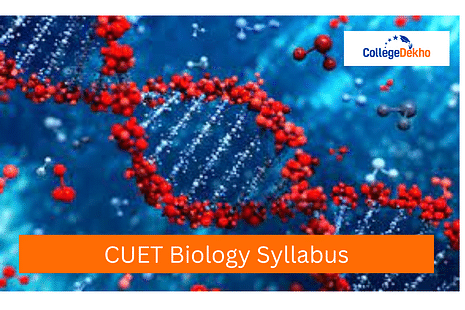CUET 2025 Biology Syllabus has been released by NTA. The Biology Syllabus includes topics such as Reproduction, Genetics and Evolution, Biology and Human Welfare, Biotechnology and its Applications and Ecology and Environment. Download syllabus PDF from here.

CUET 2025 Biology syllabus has been released. CUET Biology syllabus includes the topics and chapters taught in Class 12 CBSE. CUET Biology syllabus 2025 consists of topics like Reproduction, Genetics and Evolution, Biology and Human Welfare, Biotechnology and its Applications, and Ecology and Environment. Students willing to appear for the Biology domain subject in CUET UG 2025 , must go through the latest CUET 2025 biology syllabus. Students of CUET 2025 Biology can find the CUET Biology syllabus 2025 PDF below and the detailed syllabus for easy reference.
Solve: CUET Previous Year Question Papers with Solutions
Latest Update: CUET UG exam will be conducted from May 13, 2025, to June 03, 2025. CUET Exam City Intimation Slip 2025 has been released for the students appearing for the exam. The direct link to download CUET UG city intimation slip 2025 has been provided below.
Direct Link: CUET UG City Intimation Slip 2025 (activated)
Also Check:
CUET 2025 Biology Syllabus PDF Download
You can click on the link below to download CUET 2025 Biology syllabus
| Download: CUET 2025 Biology Syllabus PDF |
|---|
Detailed CUET 2025 Biology Syllabus
Check out the overview of the CUET Biology syllabus 2025 here:
Unit | Unit Name | Topics |
|---|---|---|
Unit I | Reproduction |
|
Unit II | Genetics and Evolution |
|
Unit III | Biology and Human Welfare |
|
Unit IV | Biotechnology and its Applications |
|
Unit V | Ecology and Environment |
|
Practice: CUET Mock Test 2025
CUET Biology Syllabus 2025
The CUET Biology Syllabus consists of 5 Units and 16 Chapters. The detailed CUET 2025 Biology Syllabus 2025 has been given below.
UnitI: Reproduction
Reproduction in Organisms : Reproduction, a characteristic feature fall organisms for continuation of species; Modes of reproduction –Asexual and sexual; Asexual reproduction; Modes- Binary fission, sporulation, budding, gemmule, fragmentation; vegetative propagation in plants.Sexual Reproduction in Flowering Plants: Flower structure; Development of male and female gametophytes; Pollination–types, agencies and examples; Outbreedings devices; Pollen-Pistil interaction; Double fertilization; Post fertilization events– Development of endosperm and embryo, Development of seed and formation of fruit; Special modes– apomixis, parthenocarpy, polyembryony; Significance of seed and fruit formation.
Human Reproduction: Male and female reproductive systems; Microscopic anatomy of testis and ovary; Gametogenesis- spermatogenesis & oogenesis; Menstrual cycle; Fertilisation, embryo development upto blastocyst formation, implantation; Pregnancy and placenta formation (Elementary idea); Parturition (Elementary idea); Lactation (Elementary idea).
Reproductive Health: Need for reproductive health and prevention of sexually transmitted diseases (STD); Birth control- Need and Methods, Contraception and Medical Termination of Pregnancy (MTP); Amniocentesis; Infertility and assisted reproductive technologies – IVF, IUI, ZIFT, GIFT (Elementary idea for general awareness).
Unit II: Genetics and Evolution
Heredity and Variation: Mendelian Inheritance; Deviations from Mendelism– Incomplete dominance, Co-dominance, Multiple alleles and Inheritance of blood groups, Pleiotropy; Elementary idea of polygenic inheritance; Chromosome theory of inheritance; Chromosomesandgenes; Sex determination–Inhumans, birds, honeybee; Linkage and crossing over; Sex-linked inheritance- Haemophilia, Colour blindness; Mendelian disorders in humans– Thalassemia; Chromosomal disorders in humans; Down syndrome, Turner’sandKlinefelter’ssyndromes.Molecular Basis of Inheritance: Search for genetic material and DNA as genetic material; Structure of DNA and RNA; DNA packaging; DNA replication; Central dogma; Transcription, genetic code, translation; Gene expression and regulation–LacOperon; Genome and human genome project; DNA fingerprinting.
Evolution: Origin of life; Biological evolution and evidences for biological evolution (Paleontological, comparative anatomy, embryology and molecular evidence); Darwin’s contribution, Modern Synthetic theory of Evolution; Mechanism of evolution–Variation(MutationandRecombination) and Natural Selection with examples, types of natural selection; Gene flow and genetic drift; Hardy-Weinberg’sprinciple; Adaptive Radiation; Human evolution.
Unit III: Biology and Human Welfare
Health and Disease: Pathogens; parasites causing human diseases (Malaria, Filariasis, Ascariasis, Typhoid, Pneumonia, common cold, amoebiasis, ring worm); Basic concepts of immunology–vaccines; Cancer, HIV andAIDs; Adolescence, drug and alcohol abuse.Improvement in Food Production: Plant breeding, tissue culture, single cell protein, Biofortification; Apiculture and Animal husbandry.
Microbes in Human Welfare: In household food processing, industrial production, sewage treatment, energy generation and as biocontrol agents and biofertilizers.
Unit IV: Biotechnology and Its Applications
Principles and Process of Biotechnology: Genetic engineering (Recombinant DNA technology).
Application of Biotechnology in Health and Agriculture: Human insulin and vaccine production, gene therapy; Genetically modified organisms-Btcrops; Transgenic Animals; Biosafety issues–Biopiracy and patents
Unit V: Ecology and Environment
Organisms and Environment : Habitat and niche; Population and ecological adaptations; Population interactions– mutualism, competition, predation, parasitism; Population attributes–growth, birth rate and death rate, age distributionEcosystems: Patterns, components; productivity and decomposition; Energy flow; Pyramids of number, biomass, energy; Nutrient cycling (carbon and phosphorous); Ecological succession; EcologicalServices– Carbon fixation, pollination, oxygen release.
Biodiversity and its Conservation: Concept of Biodiversity; Patterns of Biodiversity; Importance of Biodiversity; Loss of Biodiversity; Biodiversity conservation; Hotspots, endangered organisms, extinction, Red Data Book, biosphere reserves, National parks and sanctuaries sacred groves, in-situ & ex-situ.
Environmental issues: Air pollution and its control; Water pollution and its control; Agrochemicals and their effects; Solid waste management; Radioactive waste management; Greenhouse effect and global warming; Ozone depletion; Deforestation; Any three case studies as success stories addressing environmental issues
CUET 2025 Syllabus for All the Papers
The syllabus for all the papers of CUET 2025 can be checked here.
Students interested in finding out more about UG admissions in India can just dial the student helpline number 1800-572-9877 (toll-free) and interact with our admission experts. They can also fill up and submit our
Common Application Form
to smooth their college application process.
Stay tuned to CollegeDekho for more information on CUET 2025 Biology syllabus!
Are you feeling lost and unsure about what career path to take after completing 12th standard?
Say goodbye to confusion and hello to a bright future!

CUET Previous Year Question Paper
Was this article helpful?



















Similar Articles
Important Topics for CUET Physics 2025
How to Score 800 Marks in CUET 2025 Exam?
Important Topics for CUET Chemistry 2025
CUET Computer Science Syllabus 2025 (Released): Check Topics, Pattern, Download PDF
CUET 2025 Mathematics Important Topics: Preparation Strategy, Topic-Wise Weightage
CUET Courses for PCB Students